In 2024, the Edtech industry is experiencing remarkable growth, and its trends play a crucial role in shaping the learning landscape for teachers and learners. However, while Edtech trends promise an exciting future, businesses and startups keen on leveraging these innovations face various challenges.
These challenges include adapting to rapidly evolving technologies, ensuring the affordability of educational solutions, and addressing data privacy and security issues. In navigating this complex landscape, expert guidance and collaboration become invaluable.
Aloa, an expert in software outsourcing, is dedicated to helping businesses and startups overcome these hurdles in the Edtech industry. With a deep understanding of the latest edtech trends and technologies, Aloa offers tailored solutions that harness the power of Edtech to enhance learning experiences and outcomes.
This blog will delve into the top Edtech trends of 2024, offering insights into each trend's significance and potential impact. At the end of this blog, you will be equipped with knowledge and strategies to thrive in the ever-evolving world of Edtech, enabling you to harness the full potential of these groundbreaking innovations for your business or startup.
Whether you're developing an online math course or exploring other digital learning avenues, these trends will help you stay ahead. Stay tuned for a deep dive into the future of education technology!
Top 8 Edtech Trends To Watch and Leverage In 2024
Staying on top of the latest edtech trends is essential for educators, students, and businesses in 2024. These trends can transform our teaching and learning, enhancing the educational experience. In this article, we will explore one of the most significant trends:
1. Artificial Intelligence (AI) in Learning
AI in learning involves the application of machine learning algorithms and data analytics to customize educational content and experiences. It enables systems to adapt to individual student needs, providing tailored content and feedback. Through AI, educators can gain insights into student progress and intervene when necessary, ensuring every learner is included.
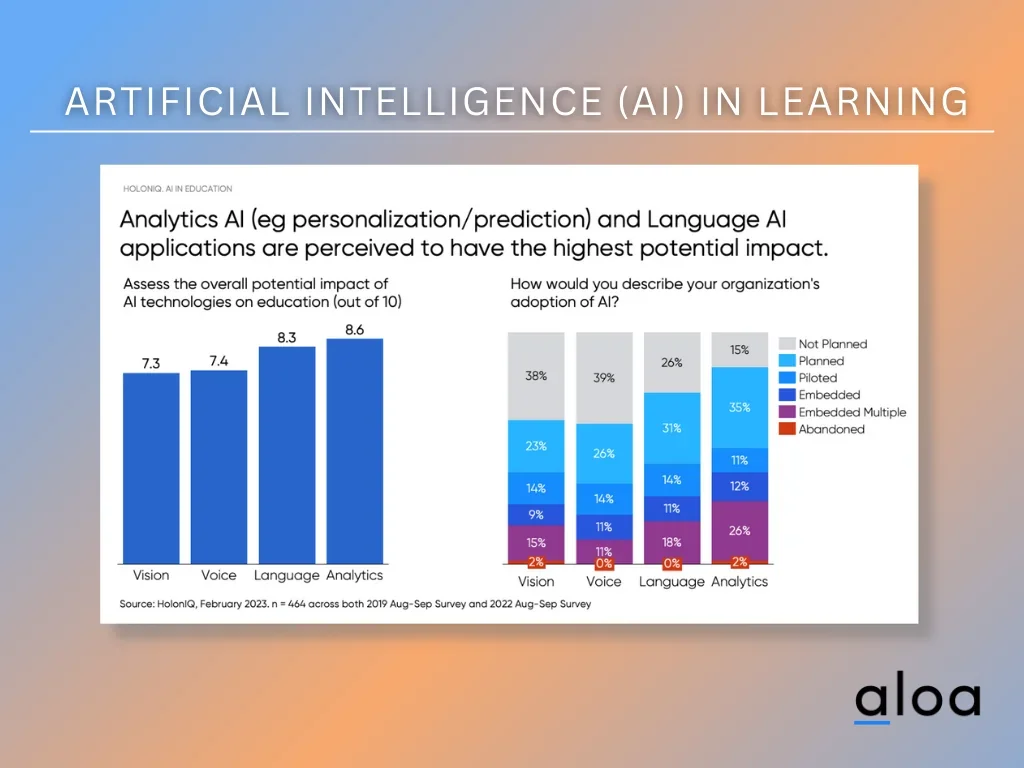
The figure highlights the potential impact of Voice, Vision, Machine Learning, and Natural Language Processing (NLP) technologies on education. While still in its early stages, Voice and Vision are emerging as essential sub-applications in Intelligent Adaptive learning systems. For example, computer vision tracks mouse eye movements and analyzes student sentiment during complex subject teaching, offering valuable insights into student performance.
Notable Features of AI in Learning
- Personalization: AI analyzes students' learning patterns and adapts content accordingly, ensuring learners receive content at their pace and level.
- Smart Content Creation: AI can generate educational content, quizzes, and exercises, reducing the manual workload for educators.
- Predictive Analytics: AI can forecast student performance, helping educators proactively address potential issues.
- Language Processing: AI-driven chatbots and virtual assistants can provide instant answers and support for students, enhancing their learning experience.
Considerations for Implementing AI in Learning
When integrating AI into learning, consider data privacy, plagiarism, transparency, and equity factors. Ensure that algorithms don't perpetuate bias and that students' personal information is handled securely. Additionally, adequate training for educators and technical support for students is crucial to maximize the benefits of AI in education. Careful planning and ethical considerations can help harness the potential of these edtech trends while addressing its challenges.
2. Virtual Reality (VR) and Augmented Reality (AR)
VR and AR technologies create immersive and interactive learning experiences, enabling students to explore and learn in virtual environments. While VR offers complete immersion in digital worlds, AR overlays digital elements onto the real world, enhancing it. These technologies open up new possibilities for engaging, experiential learning.
%2520and%2520Augmented%2520Reality%2520(AR).webp)
Schools are gradually embracing AR, as it could revolutionize teaching methods. Goldman Sachs predicts that AR might become a standard tool in education, with a potential market worth $700 million by 2025. However, cash-strapped schools need to be faster to adopt AR. A survey by Project Tomorrow shows that only 5% of US teachers use AR, with higher numbers among high school science (9%) and computer science teachers (11%). Despite challenges, investing in AR's future is increasingly compelling.
%2520market%2520in%2520education.webp)
The VR market in education is poised to surge from $21.36 billion in 2024 to $55.39 billion by 2028, with a 21% CAGR. VR adoption has grown across universities, schools, and corporations, enhancing learning experiences. It offers immersive, interactive education, from practical learning to biology studies. The COVID-19 pandemic further accelerated the adoption of VR and other immersive technologies in education, making learning more accessible and location-independent.
Notable Features of VR and AR
- Immersive Simulations: VR allows students to step into historical events, explore the human body, or even travel through space, making complex subjects more understandable.
- Hands-On Learning: AR overlays 3D models, animations, and information onto physical objects, enabling interactive and tactile learning experiences.
- Collaborative Learning: VR and AR facilitate collaboration, connecting learners from different locations and fostering teamwork and problem-solving skills.
- Personalized Education: Adaptive VR/AR platforms adjust the content to suit individual learning styles and pace, enhancing learning outcomes.
Considerations for Implementing AR and VR
Implementing VR and AR in education requires careful planning. Consider factors like accessibility, cost, and content development. Ensure the technology is inclusive, affordable, and aligned with curriculum goals. Proper teacher training is crucial to integrate these tools into the classroom effectively.
3. Blockchain in Education
Blockchain, the distributed ledger technology that underpins cryptocurrencies, has found a new home in education. Its core strength lies in ensuring data integrity, security, and transparency. In the context of education, academic records, certifications, and achievements can be securely stored and verified through a decentralized network, reducing the risk of fraud or data loss.
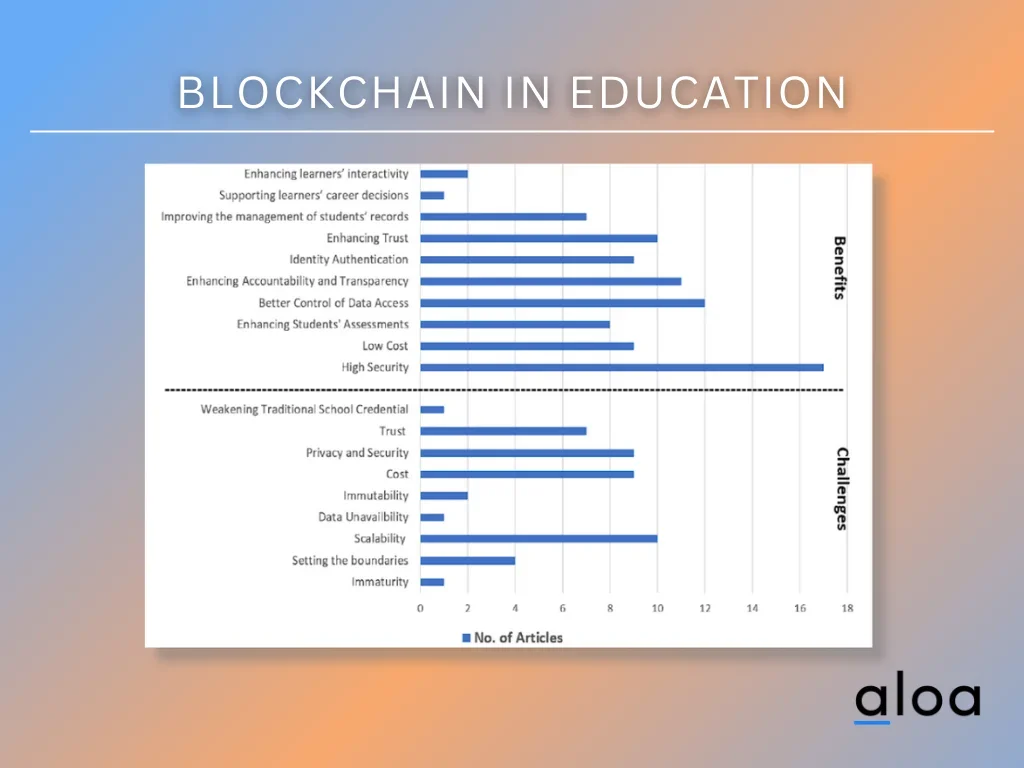
Among the benefits, the key advantages include enhanced security, control over data access, accountability, transparency, trust-building, cost reduction, improved authentication, students' assessment, the efficiency of data exchange, interactivity, and support for future career decisions. These benefits collectively pave the way for a more secure, efficient, and student-centric educational ecosystem.
On the other hand, several challenges were highlighted. These challenges underline the need for careful consideration and strategic planning when integrating blockchain into the educational framework. The benefits are promising, but addressing the challenges is essential for successfully transitioning to a blockchain-powered education system.
Notable Features of Blockchain in Education
- Immutable Record Keeping: Blockchain ensures that it cannot be altered once data is recorded. This feature guarantees the authenticity of educational documents.
- Secure Verification: Educational institutions and employers can quickly and accurately verify the legitimacy of certificates and transcripts, reducing the risk of fraud.
- Transparent Credential Sharing: Students have greater control over sharing their achievements with potential employers or other educational institutions, improving their mobility.
- Reduction of Administrative Burden: Blockchain streamlines administrative processes, reducing the paperwork and time associated with verifying credentials.
Considerations for Implementing Blockchain in Education
When implementing blockchain in education, several considerations are crucial. These include data privacy and security, interoperability with existing systems, and the need for educating stakeholders about blockchain's functionality and benefits. Additionally, legal and regulatory compliance should be considered to ensure a seamless transition to blockchain-based educational management systems.
4. Gamification
Gamification in edtech involves applying game elements and mechanics to the educational process to enhance student engagement and motivation. By integrating elements like points, badges, competition, and rewards, educators can create interactive and enjoyable learning experiences through traditionally less exciting classes.
The impact of gamification on education and learning can differ depending on the audience and the nature of the content. Studies have demonstrated that students in gamified courses tend to excel, primarily due to their enhanced focus on their studies. For instance, in a gamified cell biology class, college students outperformed their peers in lecture-based courses by a significant margin of 40%.
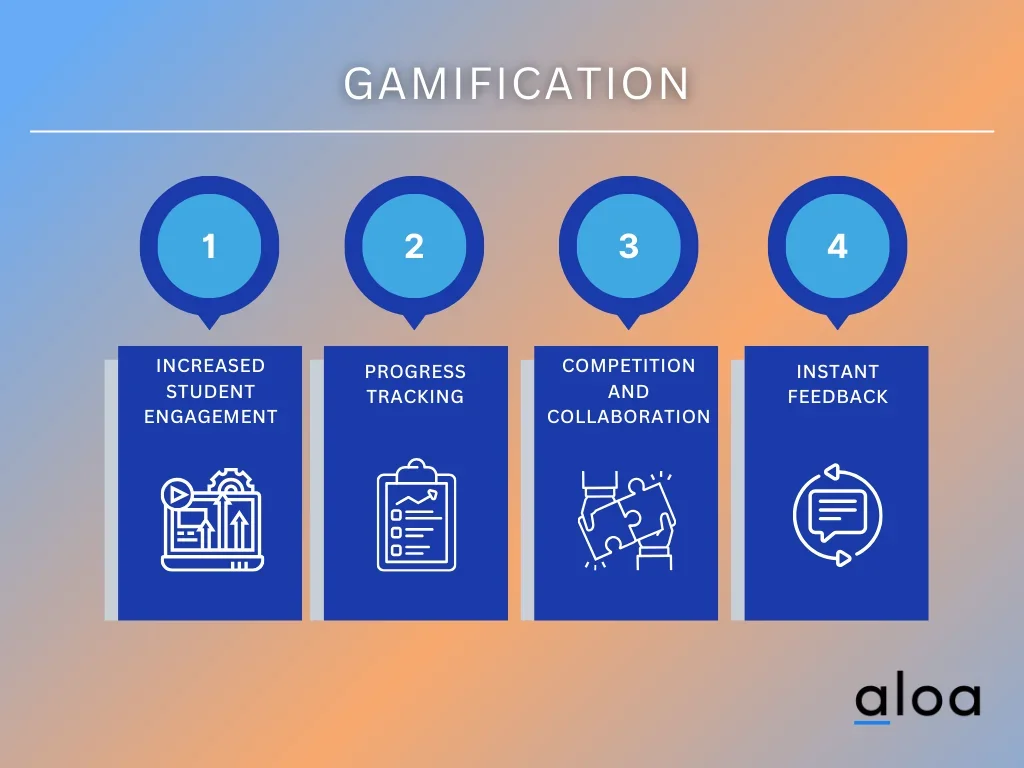
Notable Features of Gamification
- Increased Student Engagement: Gamification fosters active participation and maintains students' interest by making learning enjoyable.
- Progress Tracking: It allows educators to monitor individual progress, helping tailor instruction to students' needs.
- Competition and Collaboration: Gamification can introduce healthy competition or collaborative activities, promoting a sense of achievement and teamwork.
- Instant Feedback: Immediate feedback on performance helps learners understand their strengths and weaknesses.
Considerations for Implementing Gamification
Gamification should align with learning objectives and not just be a superficial layer of rewards. Carefully design game elements to reinforce educational goals. Ensure the chosen game mechanics are appropriate for the age group and subject matter. Lastly, gather student feedback to improve the gamified learning experience, making it more effective and enjoyable.
5. Cybersecurity in Edtech
Cybersecurity in Edtech has become an imperative concern, given the increasing reliance on digital platforms in the education sector. As edtech continues to expand, safeguarding sensitive data, protecting user privacy, and preventing cyber threats is paramount to ensure the integrity and trustworthiness of online educational environments.
Students can use technology without compromising their personal information or educational progress by fostering a secure online learning environment. Moreover, robust cybersecurity practices enhance the resilience of educational institutions, ensuring uninterrupted learning and minimizing financial losses due to cyber incidents.
Notable Features of Cybersecurity in Edtech
- Data Encryption: Edtech platforms employ robust encryption methods to secure user data, preventing unauthorized access and data breaches.
- Multi-Factor Authentication: Implementing multi-factor authentication enhances user access control and reduces the risk of unauthorized logins.
- Secure Cloud Storage: Edtech companies use secure cloud solutions to store and organize educational content and student information, ensuring data integrity and accessibility.
- Regular Security Audits: Continuous security audits and updates to identify and address vulnerabilities promptly.
Considerations for Implementing Cybersecurity in Edtech
Implementing cybersecurity in Edtech requires a proactive approach. Edtech providers should focus on educating staff and users on safe online practices. A strong incident response plan and compliance with data protection regulations, such as GDPR and COPPA, are essential to maintain trust in the edtech ecosystem. By prioritizing cybersecurity, edtech companies can provide a safe and reliable learning environment for students and educators alike.
6. Cloud-Based Learning
Cloud-based learning, one of the prominent edtech trends, revolutionizes how education is delivered and accessed. It involves using cloud computing services to host and deliver educational content, making learning more flexible and accessible.
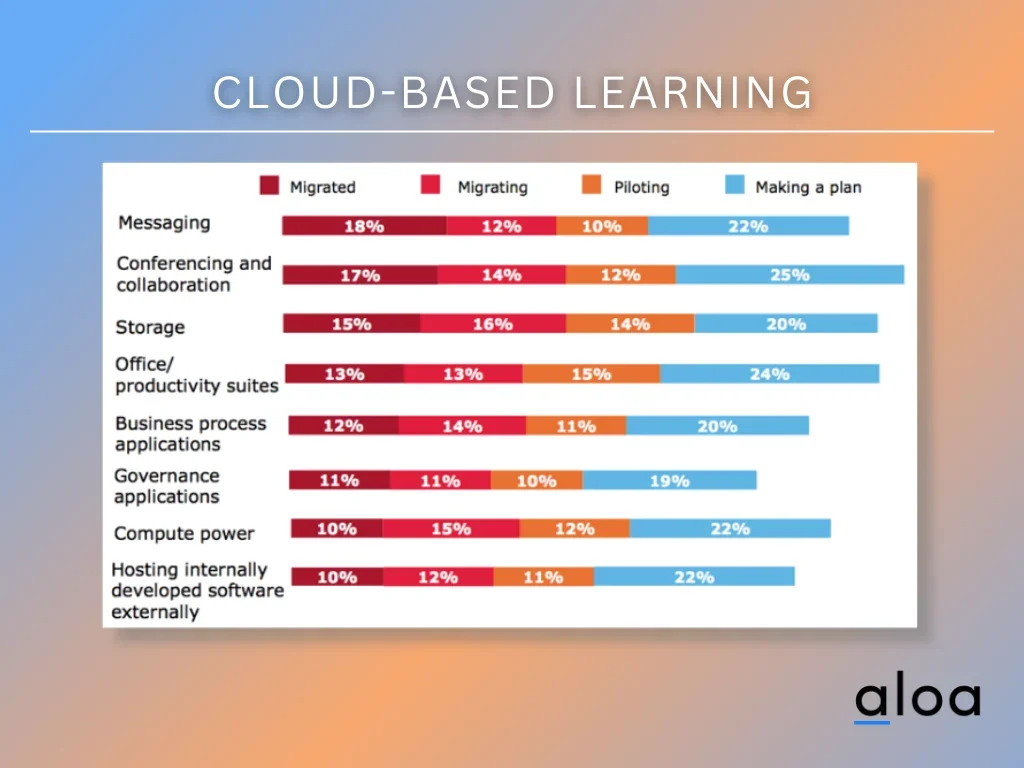
Aligned with the focus on boosting productivity, cloud migration has seen messaging take the lead, closely followed by conferencing and collaboration tools. Cloud-based communication solutions expand communication options, significantly impacting work and study dynamics. These tools are readily accessible on various devices with internet connectivity, simplifying work and study for employees and students.
Notable Features of Cloud-Based Learning
- Scalability: Cloud-based platforms can quickly scale to accommodate diverse user bases, making them suitable for individual learners and large institutions.
- Remote Learning: The cloud enables remote learning, allowing students to access resources and collaborate from anywhere, promoting inclusivity and flexibility.
- Cost-Efficiency: Institutions can reduce infrastructure costs, as cloud-based learning eliminates the need for extensive on-premises hardware and maintenance.
- Data Security: Advanced security measures protect sensitive educational data stored in the cloud, ensuring the privacy of students and educators.
Considerations for Implementing Cloud-Based Learning
When implementing cloud-based learning, consider factors such as selecting a reliable cloud service provider, data privacy regulations, and user training. To reap the full benefits of cloud-based learning, ensuring data security, compliance with regulations, and a seamless user experience is essential.
7. Learning Management Systems (LMS)
Learning Management Systems (LMS) are integral to the evolving edtech landscape. These platforms serve as digital hubs for educational content, facilitating the management, delivery, and tracking of online courses and training programs. LMS has witnessed substantial growth in the edtech industry, offering a centralized solution for both educators and learners.
.webp)
About 75% of users note a positive influence of their organization's LMS on student satisfaction, teacher/admin productivity, and facilitating teaching during the COVID-19 pandemic. The only area where the majority didn't see a positive impact was the cost of teaching, which is unsurprising considering the significant annual investment schools make in these systems, often in the five-figure range.
Notable Features of LMS
- Course Management: LMS enables educators to create, organize, and deliver courses efficiently, streamlining content creation and distribution.
- Tracking and Analytics: They provide detailed insights into learner progress, helping instructors identify areas for improvement.
- Collaboration Tools: Many LMS incorporate features such as discussion forums and chat functions, promoting interactive learning and peer collaboration.
- Mobile Accessibility: LMS often offers mobile apps, allowing users to access educational content on the go, enhancing the accessibility of learning materials.
Considerations for Implementing LMS
When implementing an LMS, consider scalability, user-friendliness, and integration with existing systems. Additionally, ensure adequate training and support for educators and learners to maximize the platform's benefits. Adhering to these considerations can lead to a successful integration of an LMS into your educational institution or business.
8. Big Data in Education
The utilization of Big Data in education, one of the prominent edtech trends, is transforming the learning landscape. Big Data involves collecting and analyzing vast datasets to derive meaningful insights, and it has found significant applications in the education sector.
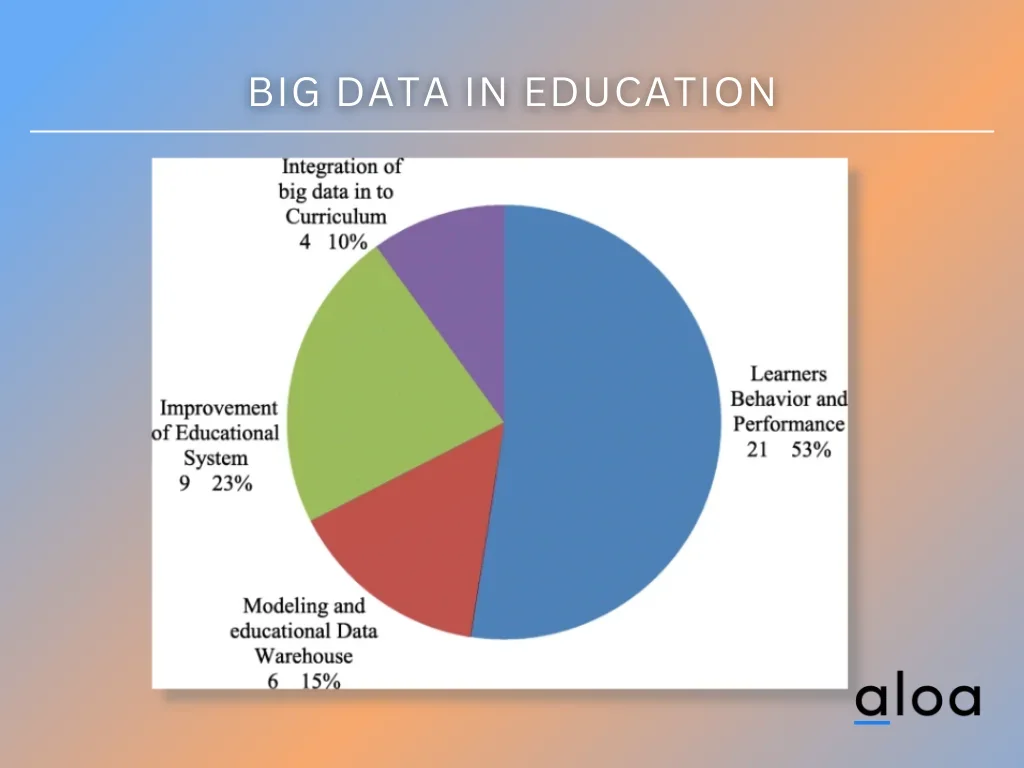
The figure illustrates vital research themes in big data in education. These themes encompass learner behavior and performance, educational system enhancement, and curriculum integration.
Research themes indicate that big data in education has positively impacted the field. It enhances teaching and learning through analytics, adaptive strategies, and improved user satisfaction. The data-driven insights help optimize educational systems and curriculum, ultimately improving the overall learning experience for students.
Notable Features/Use Cases of Big Data in Education
- Personalized Learning: Big Data allows educators to tailor learning experiences to individual student needs by tracking performance and adapting content accordingly.
- Predictive Analytics: Predictive modeling helps identify students at risk of falling behind, enabling timely intervention to improve retention and graduation rates.
- Curriculum Enhancement: Data-driven insights help develop curriculum, ensuring that course content remains up-to-date and relevant.
- Resource Allocation: Educational institutions can optimize resource allocation efficiently using staff and budget.
Considerations for Implementing Big Data in Education
Implementing Big Data in education must address privacy, security, and ethical considerations. Additionally, ensuring educators and staff are trained to interpret and act upon data insights is crucial for successful integration. Careful planning and ethical practices are vital to leverage the full potential of Big Data in education.
How to Stay Ahead of the Curve In Edtech Trends
The Edtech industry has witnessed a remarkable transformation in recent years, especially in higher education. With the integration of cutting-edge tech and online learning, Edtech companies are changing the educational landscape. Staying ahead of the curve in Edtech trends is crucial to thrive in this dynamic sector. Here are five essential steps to keep you at the forefront:
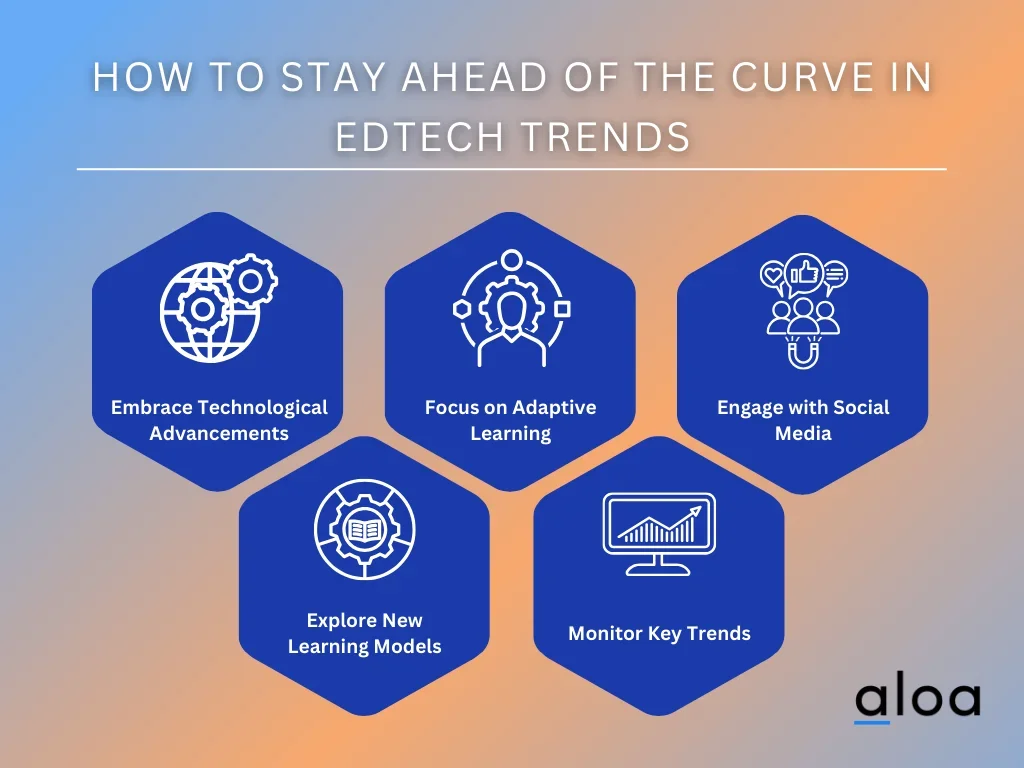
Embrace Technological Advancements
The rapid evolution of technology is a defining aspect of Edtech trends. Stay updated with the latest tech innovations, including machine learning, AI, and cloud storage. By integrating these digital technologies into your educational content and platforms, you can enhance the learning process, improve accessibility, and adapt to the changing needs of the education sector.
Focus on Adaptive Learning
Adaptive learning is a game-changer in Edtech. Utilize algorithms to tailor learning methods to individual students, addressing their strengths and weaknesses. This boosts student performance and bridges the digital divide, ensuring that students from all backgrounds have equal opportunities for success.
Engage with Social Media
Social media is a powerful tool for Edtech. Engage with students and educators through platforms like Google and educational forums. It's a great way to gather student data, understand their needs, and promote critical thinking. Interacting through these platforms can also help in disseminating educational content effectively.
Explore New Learning Models
Traditional methods are needed to meet the demands of today's education industry. Explore new learning models that offer students a flexible and interactive way of acquiring knowledge. Edx and online courses have opened up a world of possibilities, making complex concepts easier to grasp.
Monitor Key Trends
To stay ahead, you must be aware of the top edtech trends. Keep an eye on emerging technologies, learning models, and educational platforms. Student data and the analysis of their performance should guide your decision-making. Be ready to adapt and embrace new technologies that improve education delivery.
Key Takeaway
Edtech trends for 2024 are crucial for the education industry's continued growth and innovation. These trends encompass cutting-edge technological advancements shaping how we teach and learn. Integrating these edtech trends into your business is crucial to staying competitive.
Incorporating these trends offers several benefits to businesses and startups in the edtech sector. It ensures they remain at the forefront of technological advancements, enhancing their products and services to cater to modern learners. By staying updated with edtech trends, businesses can improve the learning experience, adapt to changing student needs, and reach a wider audience.
Embracing these edtech trends can increase customer satisfaction, market growth, and a competitive edge. To learn more about edtech trends and how to implement them effectively, contact [email protected]. Stay ahead in the edtech industry by embracing these essential trends.

